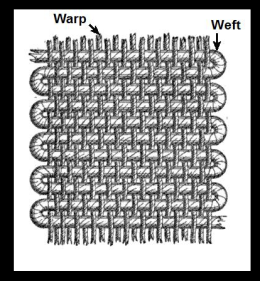I struggle with the warp. It gets tangled. I loathe the math. The endless knots. The noisy spindles. A loom requires a delicate touch that I have yet to master. Someday.
Unlike measuring the warp, I find building the weft is pure joy. It’s an easy motion of back and forth. The shuttle moves quickly between the rows. You can “throw the shuttle.” Meditative. Deliberate. The ups and downs of tying the warp is necessary, I know. The warp will eventually support the weft. They’ll eventually need one another. You can’t prefer one over the other. Weaving on a loom requires a delicate touch that I have yet to master. Someday.
The different fibers, the loom as machine, the creation of fabric is all so satisfying. So interesting. So appealing.
Here’s the thing.
I really have nothing to say (a memoir) but I want to write about weaving. Eventually–wait for it—I’ll weave the following ideas together.
1] My friends @ordinarysublime and @nooksackknitter participated in this amazing project! Humble brag that I know two of the 51 artists. From the looks of this review it’s a pretty stunning show. My favorite words are in bold.
From The LA Times: For Ellen Lesperance and Helen Mirra, the message is woven into the art
The works of Ellen Lesperance and Helen Mirra on view at the Armory Center for the Arts in Pasadena lay out a quietly powerful network of ideas around work, bodily presence and activism.
The show opens with a collaborative project initiated by Mirra in which she asked 51 weavers each to create a textile according to her specifications. Each piece is roughly square, made from undyed yarn, in dimensions that match the length of the weaver’s arm. Each has seven stripes, whose width is determined by that of the weaver’s hand. The works are little self-portraits, recording the measurements of the hands and arms that made them.
The pieces highlight how physical labor is measured and embedded in the warp and weft of weaving, which is essentially a grid. This typically impassive structure here serves as a meeting point where the impulse to reduce everything to numbers meets the irreducible physicality of the body.
2] I wrote about weaving on December 10, 2015. Here’s the post:
The Warp & The Weft
In a search for an image to explain the warp and weft in fabric, a simple image appears from wikipedia:
An artist named Kumi Yamashita also appears in the same search (source). She removes part of the warp and the weft in fabric to create something new.
She describes her delicate and precise art:
Sometimes there is something beautiful about things falling apart. Undoing one thing while simultaneously creating another.

(Note to self, here are more threads from the warping board) See also Many Paths To & For Personalization (source).
3] Walter Benjamin: Work on good prose has three steps: a musical stage when it is composed, an architectonic one when it is built, and a textile one when it is woven.
Until then, here are the frayed fibers/words that I have yet to tie together.

I’m honored to be part of the project. Something not noted in the LA Times article is that each weaver completed two of these little self portraits. One goes in the exhibit, the other was sent to another weaver. Mine arrived from Staffordshire, UK from a Ms Margaret Lowndes. Our local fibers both included Romney sheep. Her gift to me arrived in the mail on a day that brought me great disappointment, but receiving this piece of love (and that is what it is) reminded me that life is so much more than a job and so much more than what we can see today. I likely will never meet Margaret (but I WILL see this exhibit). Her labor however – her demonstration of our interdependence in our warps and wefts – means a great deal to me.
I know from the interwebs that Margaret is probably 65 years old. She knows so much more than me. But this little panel of fiber collected close to her and the woven piece that she produced can tell me so much more. So, not to be a downer on all your tech talk, Aly, but we need more time touching and communing with our more earthly elements. This makes us better.
LikeLike
You can be a downer on the tech talk any time, kitten, it’s good for me. I love your description of Margaret’s work: “her demonstration of our interdependence in our warps and wefts.” And of course, in my longer version of this essay/blog, I discuss how you would stop by my house once a week for three weeks to tell me to rip it up. I was so sure I had figured it out, and every time it was a mistake. Funny that was 2008, right? That time in Ballard is marked by that weaving project, our dog walks, and port-o-lets en route to the Locks. Glad that era is over, but I wish you were still my neighbor. Someday, I’ll have a little room with a loom. Wish I could join you for that trip to LA. Thanks for reading. And listening to so many of my words.
LikeLike